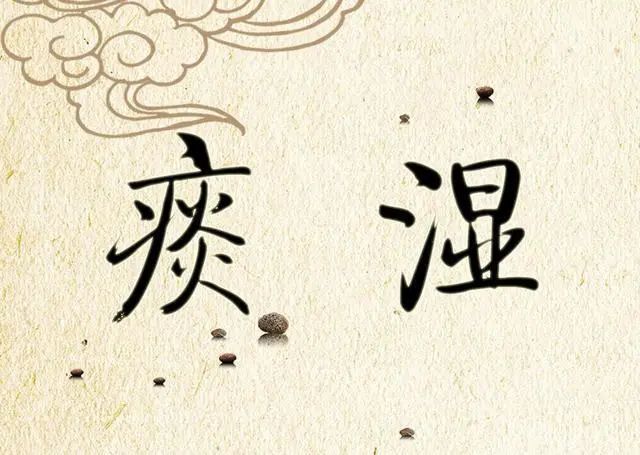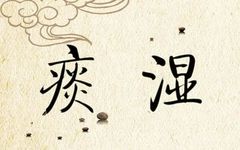Many individuals have a damp-phlegm constitution, exhibiting various symptoms. The main manifestations include the following points, which you can refer to in order to see if you have a damp-phlegm constitution.
Excessive facial oiliness, oily hair, pale yellow complexion, prone to acne, a sticky sensation in the mouth, chest tightness with phlegm, excessive sweating or unusual odors, abdominal obesity and softness, heavy limbs, unsatisfactory or loose stools, cloudy or foamy urine, a white or greasy tongue coating, and a swollen tongue with teeth marks.
When discussing phlegm and dampness, one must think of the spleen, which governs transformation and transportation. If the water consumed or food ingested cannot be transformed into body-usable fluids, it will turn into dampness. When dampness accumulates, it becomes phlegm. Prolonged accumulation of dampness or heat can lead to the formation of phlegm.
The formation of a damp-phlegm constitution is significantly related to the spleen’s function. There are many reasons for the spleen’s dysfunction, such as consuming cold and raw foods that harm the spleen, excessive worry and overthinking that injure the spleen, and excessive liver qi restraining the spleen’s earth element.
In addition to its relationship with the spleen, the formation of phlegm is also related to the lungs. For instance, when wind or cold pathogens invade the lungs, the lung’s functions of dispersing and descending are disrupted, preventing the transportation of fluids to the bladder, leading to the accumulation of phlegm.
The formation of phlegm is also related to the kidneys. The bladder has a qi transformation function, which is governed by the kidneys. If kidney qi is deficient, the bladder’s qi transformation function weakens, similar to how insufficient fire cannot boil water, leading to the overflow of fluids and the formation of phlegm.
Additionally, there are other causes for phlegm formation, such as excessive water intake overwhelming the spleen’s ability to transform, leading to fluid retention; or consuming rich, sweet, and greasy foods that generate excessive turbid qi in the stomach, which can create heat and condense fluids into phlegm.
In Traditional Chinese Medicine (TCM), it is said that many diseases are caused by phlegm. Some seemingly complex diseases are actually related to phlegm, such as polyps, nodules, lipomas, and uterine fibroids.
From a TCM perspective, these conditions are seen as blockages, such as qi stagnation, blood stasis, cold accumulation, and phlegm nodules. Prolonged blockages can solidify into masses, which Western medicine refers to as nodules, hyperplasia, and fibroids.

For individuals with a damp-phlegm constitution, the focus of treatment is on eliminating dampness and resolving phlegm. Depending on the different symptoms, commonly used TCM formulas include Er Chen Wan (Er Chen Pill), Liujun Wan (Six Gentlemen Pill), Xiangsha Liujun Wan (Aromatic Sand Six Gentlemen Pill), Pingwei San (Ping Wei Powder), and Shenling Baizhu San (Shen Ling Bai Zhu Powder).
Here are several different methods for treating various phlegm syndromes.
Cold Phlegm: Phlegm is white, easily expectorated, accompanied by slight cold intolerance, preference for warm drinks, thin white tongue coating, or difficulty breathing when lying down.
Reference: Xiao Qing Long Jia Jian (Minor Blue Dragon Decoction Modification): 9g of Gui Zhi (Cinnamon Twig), 10g of Jiang Ban Xia (Pinellia Tuber), 6g of Gan Jiang (Dried Ginger), 3g of Xi Xin (Asarum), 10g of Ku Xing Ren (Bitter Apricot Kernel), and 6g of Bai Jie Zi (White Mustard Seed).
Heat Phlegm: Phlegm is yellow and viscous, or difficult to expectorate, with a preference for cold drinks and a red tongue with a yellow coating, which may arise from heat pathogens injuring the lungs or from a cold or fever.
Reference: Xie Bai San Jia Jian (Xie Bai Powder Modification): 10g of Sang Bai Pi (Mulberry Root Bark), 10g of Di Gu Pi (Lycium Root Bark), 5g of Gan Cao (Licorice), 30g of Sheng Shi Gao (Raw Gypsum), 10g of Huang Qin (Scutellaria), 10g of Ku Xing Ren (Bitter Apricot Kernel), and 6g of Dan Nan Xing (South Star).
Damp Phlegm: Phlegm is white and clear, with chest tightness and abdominal distension, more phlegm in the morning or after meals, cough due to phlegm, expectoration is slow, thin white or thick white tongue coating, accompanied by heavy limbs, fatigue, or loose stools.
Reference: Er Chen Tang Jia Jian (Er Chen Decoction Modification): 10g of Zhi Ban Xia (Processed Pinellia Tuber), 10g of Hua Ju Hong (Citrus Peel), 10g of Fu Ling (Poria), 5g of Zhi Gan Cao (Honey-Fried Licorice), 10g of Ku Xing Ren (Bitter Apricot Kernel), 15g of Yi Yi Ren (Job’s Tears), 10g of Cang Zhu (Atractylodes), and 10g of Bai Zhu (White Atractylodes).
The saying goes, “The spleen is the source of phlegm, and the lungs are the storage for phlegm,” which many people are familiar with. However, many do not know the next part: The kidneys are the root of phlegm.
For example, while Er Chen Tang (Er Chen Decoction) is excellent for resolving phlegm, it only addresses the symptoms. The root cause of phlegm lies in the kidneys; if kidney qi is insufficient, the bladder’s function is impaired, preventing the transformation of fluids into urine, leading to the formation of dampness and phlegm.
Here, I recommend a phlegm-resolving formula from the book Yi Xue Zhong Zhong Can Xi Lu: Li Phlegm Decoction: 30g of Qian Shi (Euryale Seed), 12g of Qing Ban Xia (Clear Pinellia Tuber), 9g of Hei Zhi Ma (Black Sesame), 6g of Bai Zi Ren (Biota Seed), 6g of Hang Bai Shao (White Peony), 6g of Chen Pi (Aged Tangerine Peel), and 6g of Fu Ling (Poria).
This formula is especially suitable for stubborn damp-phlegm, such as a persistent cough with white phlegm lasting for over a year, with phlegm that is white and foamy, dissolving in water, or accompanied by chest fullness, gastric distension, hiccups, excessive phlegm, shortness of breath, palpitations, and dizziness.
A damp-phlegm constitution develops gradually, and treatment should be progressive, as “three feet of ice does not form in a single day.”
Individuals with a damp-phlegm constitution can frequently consume Yi Yi Ren (Job’s Tears), Chi Xiao Dou (Adzuki Beans), Bai Zhu (White Atractylodes), Cang Zhu (Atractylodes), Qian Shi (Euryale Seed), He Ye (Lotus Leaf), Chen Pi (Aged Tangerine Peel), Bai Bian Dou (White Hyacinth Bean), and Xie Bai (Garlic Chives), while avoiding sour and cold foods, especially less consumption of sour foods like hawthorn and black plums.
In addition to herbal treatment, one can also use Yi Yi Ren (Job’s Tears), He Ye (Lotus Leaf), Pi Pa Ye (Loquat Leaf), and Shan Yao (Chinese Yam) to cook congee with japonica rice, as congee is the easiest to digest and absorb, and will not burden the spleen and stomach.
Individuals with a damp-phlegm constitution often experience coughing. When it comes to coughing, many people think about how to suppress it. However, coughing is not necessarily a bad thing; it is a way for the body to expel waste.
The membranes of the lung alveoli act like a screen, accumulating dust and dirt over time. Coughing can vibrate the lungs and expel these impurities through the airways.
For instance, exposure to dust or secondhand smoke can trigger coughing, which is a natural response of the body to expel foreign substances.
 Phlegm-Resolving Divine Decoction, a must-try for those with a damp-phlegm constitution.How to regulate cold hands and feet in women?Left Left, licensed pharmacist, TCM enthusiast, engaged in the pharmaceutical industry for many years.Original space, gathering pharmaceutical knowledge, focusing on rational medication.
Phlegm-Resolving Divine Decoction, a must-try for those with a damp-phlegm constitution.How to regulate cold hands and feet in women?Left Left, licensed pharmacist, TCM enthusiast, engaged in the pharmaceutical industry for many years.Original space, gathering pharmaceutical knowledge, focusing on rational medication. The TCM and Western medicine mentioned in this article are for educational exchange purposes only.TCM emphasizes dialectical treatment; please use medications under the guidance of professionals.
The TCM and Western medicine mentioned in this article are for educational exchange purposes only.TCM emphasizes dialectical treatment; please use medications under the guidance of professionals.

